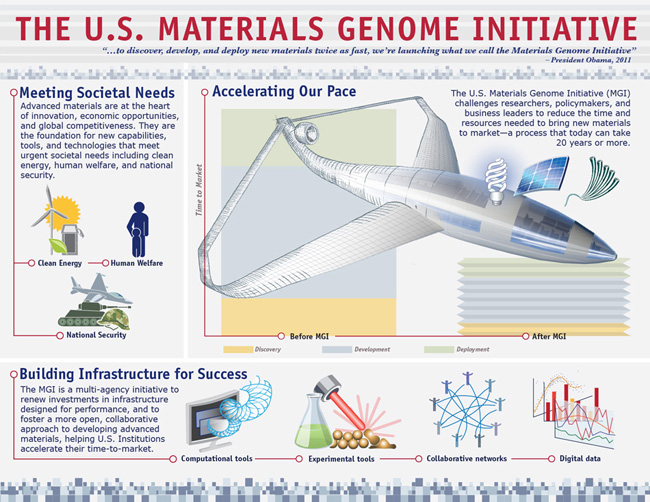Last month, the National Science Foundation (NSF) and the Department of Energy (DOE) announced more than $25 million of funding for innovative materials-science research projects. The research awards are a significant milestone for the Administration’s Materials Genome Initiative (MGI)—a collaborative effort of public, private, and academic leaders to make the discovery, development, and deployment of cutting-edge materials faster and cheaper than ever before.
Advanced materials are essential to human well-being and are the cornerstone for emerging industries such as clean energy and critical sectors like public health and national security. They are the basis for longer-lasting batteries that power our mobile devices; lightweight bullet-proof vests that protect soldiers; and improved packaging that keeps food fresher and healthier for kids. Accelerating the time it takes for these new materials to move from the lab bench to store shelves can help address urgent societal challenges while boosting our manufacturing economy.

The MGI seeks to capitalize on new and sophisticated computer modeling technologies, next-generation experimental tools, and broader access to scientific data about materials to achieve the goal of faster and cheaper new materials. Examples of newly funded projects include:
- A new software center led by Lawrence Berkeley National Laboratory and Massachusetts Institute of Technology that will use computer simulations to rapidly prototype a new generation of electrolytes for lithium ion batteries. The batteries could significantly improve battery lifetime and performance, helping electric cars travel further on a single charge and enabling better energy storage for the electrical grid. (DOE)
- A collaboration between University of Washington and General Motors to develop new composite materials that capture waste heat for conversion into usable electricity—a function that could help make next-generation automotive engines more energy efficient and require less fossil fuel. (NSF)
- A software center at University of Michigan that will develop a suite of software tools to predict the behavior of magnesium alloys and improve their properties for use in light-weight vehicles. (DOE)
- A new software center led by University of Minnesota that will develop computer algorithms for the design of porous materials used in carbon capture and sequestration technologies to remove carbon dioxide from power plant exhaust and reduce atmospheric pollution. (DOE)
- A collaboration between scientists from University of Pennsylvania and University of Delaware to use computer models to predict and assemble biomaterials that may enable higher-performing, lower-cost solar energy applications. (NSF)
- A project by researchers from University of Virginia and University of Alabama Tuscaloosa that will model, synthesize, and test “half-metal” materials to be incorporated into circuits for faster computer memory. (NSF)
- Support for a new collaborative research network between University of Illinois and Oak Ridge, Sandia, Argonne, and Lawrence Livermore National Laboratories to develop computer code to better predict the behavior and performance of materials such as catalysts and semiconductors. (DOE)
These grants come at the end of a busy year for MGI. Earlier in 2012, 170 stakeholders convened at the White House to discuss how the materials community could achieve the ambitious target of shrinking the time needed to discover, develop, and utilize new materials. In the six months since, we have seen over $60M in Federal grants for new infrastructure that will help advance this goal; participated in a NIST-led workshop that set the stage for new modes of materials data handling; and obtained pledges from more than 100 stakeholders in universities and industry to take the necessary measures in their own institutions to seed change in the materials community.
Stay tuned for information about how we will keep up this momentum going forward at: http://www.whitehouse.gov/mgi
Cyrus Wadia is Assistant Director for Clean Energy and Materials R&D at OSTP
Meredith Drosback is a TMS fellow at OSTP
